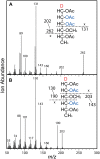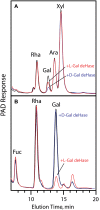Novel rhamnogalacturonan I and arabinoxylan polysaccharides of flax seed mucilage
- PMID: 18667723
- PMCID: PMC2528086
- DOI: 10.1104/pp.108.123513
Novel rhamnogalacturonan I and arabinoxylan polysaccharides of flax seed mucilage
Abstract
The viscous seed mucilage of flax (Linum usitatissimum) is a mixture of rhamnogalacturonan I and arabinoxylan with novel side group substitutions. The rhamnogalacturonan I has numerous single nonreducing terminal residues of the rare sugar l-galactose attached at the O-3 position of the rhamnosyl residues instead of the typical O-4 position. The arabinoxylan is highly branched, primarily with double branches of nonreducing terminal l-arabinosyl units at the O-2 and O-3 positions along the xylan backbone. While a portion of each polysaccharide can be purified by anion-exchange chromatography, the side group structures of both polysaccharides are modified further in about one-third of the mucilage to form composites with enhanced viscosity. Our finding of the unusual side group structures for two well-known cell wall polysaccharides supports a hypothesis that plants make a selected few ubiquitous backbone polymers onto which a broad spectrum of side group substitutions are added to engender many possible functions. To this end, modification of one polymer may be accompanied by complementary modifications of others to impart functions to heterocomposites not present in either polymer alone.
Figures






References
-
- Anderson E (1933) The preparation of l-galactose from flaxseed mucilage. J Biol Chem 100 249–253
-
- Anderson E, Crowder JA (1930) The composition of an aldobionic acid from mucilage. J Biol Chem 52 3711–3715
-
- Anderson E, Lowe HJ (1947) The composition of flaxseed mucilage. J Biol Chem 168 289–297 - PubMed
Publication types
MeSH terms
Substances
LinkOut - more resources
Full Text Sources
Other Literature Sources

